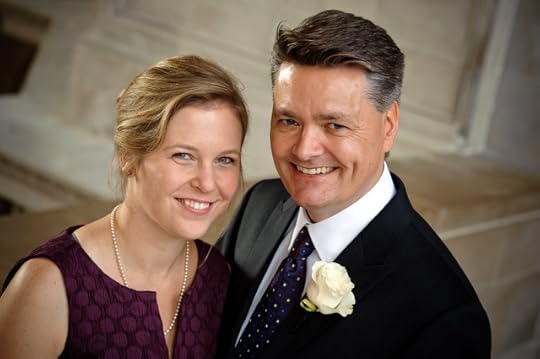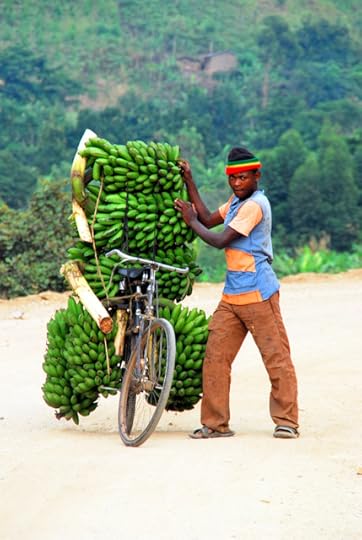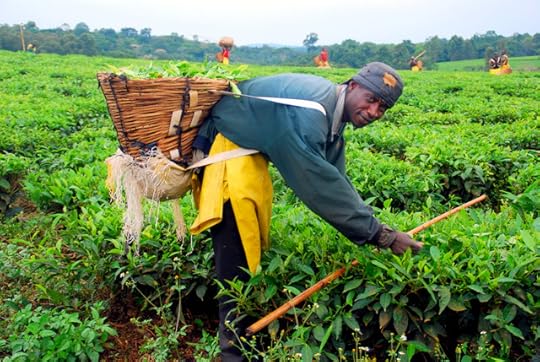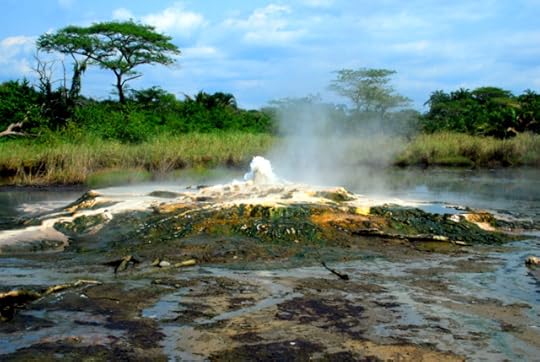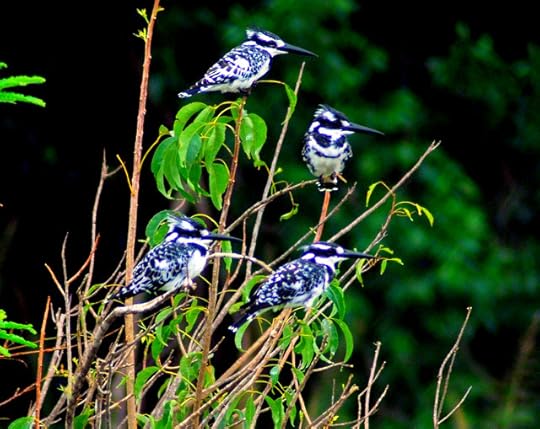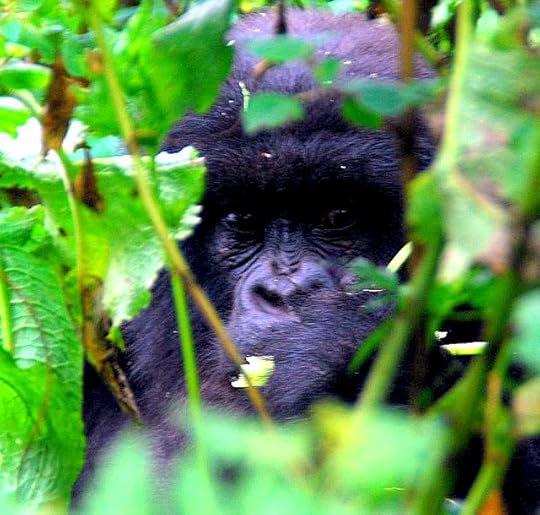Roderick Phillips's Blog
August 1, 2014
Year of Wonder – Epilogue
So that’s it. Our Year of Wonder is over. Thank you for tuning in and following along with our adventures. I don’t think Christi and I could have done more in the time we had; perhaps you could argue we did too much. It’s only now, looking back that we can begin to take in all the amazing experiences we had. One of the hardest tasks was actually breaking free from the clutches of society. You’d be surprised at how far the rapacious claws of society penetrate into each of our lives. The important thing is that we did it and we got to explore a world beyond our understanding. There is no doubt we were uncomfortable at times, had no clue what was going on most of the time (an advert for learning a second language), but through the kindness and patience of many locals we got by. I am also keenly aware that many of the countries we visited underwent dramatic and violent change not long after we left (notably Mali and the countries of the Arab Spring). The political landscape in Africa is forever changing and I doubt whether we could repeat our route given the current upheavals. Which brings me to another point. Christi and I had a great time on our Year of Wonder. I hope you enjoy your own unique experiences on whatever journey you choose.
Our travels did not entirely end with our arrival in Barnstaple by the way. Within a week we were in Poland visiting family and then spent several days exploring London, culminating in a trip to Stamford Bridge to watch my beloved football team, Chelsea. We even won the game. Christi’s family live in Los Angeles so that was our next stop. And that was an emotional reunion. It was around this time that our bodies crashed. Adrenaline had kept us going for about 99% of our Year of Wonder, but with no buses to catch, mountains to climb, jungles to hike through, or photos to take (and we took thousands), our adrenaline levels plummeted. For our first few days in Los Angeles all we did was eat, sleep and revel in the good fortune and convenience of living in a westernized country. We finally moved back to Northern California at the end of August, but even then not to San Francisco. I mean the real north of California. We house sat for a month at Christi’s Dad’s place, while the tenant in our San Francisco condo reluctantly moved out.
It’s around this time that we realized we needed jobs. We were not destitute (I’m too good a planner for that), but this was the next step in our reintegration back into society. Christi was offered a job within two weeks of starting her search and returned to UCSF in mid-October. With zero pressure on me now, I enjoyed a more relaxed return to the workforce landing my current job in a few months. In early October we moved back into our condo in San Francisco and recovered our cats from various family members. I don’t think Rembrandt and Witch Hazel quite embraced the Year of Wonder in the same way as Christi and I did, but I think they have finally forgiven us for abandoning them. Our engagement (I proposed on the summit of Kilimanjaro, if you recall) turned into marriage 15 months later and nine months after that (we really are very good planners) Alexander David Phillips arrived. He is of course a gem and we are grooming him for a life of travel. And amid all this chaos, I also found time to write and publish my debut novel, Weary Heart, a gut-wrenching tale of love and test tubes. Feel free to pop over to Amazon and pick yourself up a copy. It’s not bad, even if I do say so myself.
People ask us, knowing what you know now, would you do it again?
Absolutely, we had a fine time.
(By the way, Alexander has just told me he wants to go traveling, so the planning truly starts now!)
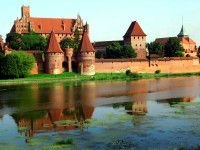
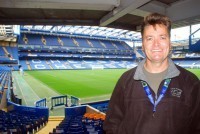




Blog post by Roderick Phillips, author of Weary Heart – a gut-wrenching tale of love and test tubes.
The post Year of Wonder – Epilogue appeared first on Roderick Phillips.
July 28, 2014
Africa to Europe, Days 364-365
It is remarkable to think that Christi and I have slept our last night in Africa; that our Year of Wonder is, to all intents and purposes, over. All that is left is the return journey. We are homeward bound and I fervently hope that there will be no adventures on the way to Barnstaple, my sleepy hometown in the southwest of England. Our last morning at the Backpackers hostel in Kampala is spent packing and repacking our bags. Even though we have been very judicious in the choice of souvenirs we purchased our bags are still full to bursting. Indeed, Christi’s red Roll Away has earned the title, The Beast, because it is so damn heavy. Fortunately she does not need to heave it onto her shoulders unlike my backpack. We taxi to Entebbe international airport. Security is tight after the recent terrorist attacks in Kampala and even before we enter the airport itself our papers are checked, our luggage inspected, and even the taxi is scrutinized. I have to admit that prior to coming to Uganda, I had no idea that Entebbe was a town / airport on Lake Victoria to the southwest of Kampala. I knew the phrase ‘Raid on Entebbe’, but it was our very beaten up Lonely Planet Guide to Africa that connected the dots. An Air-France flight originating in Tel Aviv in July 1976 was hijacked by Palestinian and German terrorists and ultimately taken to Entebbe airport in Uganda. The terrorists were welcomed by the Ugandan dictator Idi Amin. Obviously, the Israeli security forces were not going to stand for this and on 4th July 1976 (America’s bicentennial) 100 Israeli commandos flew 2,500 miles from their base to effect a rescue. 102 Israeli hostages were saved, while 3 lost their lives. All the hijackers and 45 Ugandan soldiers were also killed. The only casualty among the commandos was Yonatan Netanyahu, older brother of current Israeli Prime Minister, Benjamin Netanyahu. Somber stuff, but our flight today is reassuringly dull.
We enjoy a wonderful sunset, our last in Africa, aboard Ethiopian Airways flight 810 to Addis Ababa (capital of Ethiopia). There are no direct flights to London and it seems fitting that our last stop should be in Ethiopia, our most favorite country in Africa. We eat a final meal of injera and wat talapia while we wait for our connection. Injera is the national dish in Ethiopia and something of an acquired taste. It is a sourdough risen flatbread, grayish in color and rather spongy. The texture of injera reminds me of carpet underlay – but much tastier.
Our overnight flight from Addis Ababa to London lands on time. On arrival, I had hoped for serene scenes of calm organization. However, aside from the fact that the majority of faces are now white rather than black (which takes a bit of getting used to), the chaos is reminiscent of, dare I say it, Arua Park in Kampala. As a British citizen I slip into the country fairly easily, but poor Christi is at the end of a long line that barely moves and the passengers are becoming very frustrated. The Beast is then the last bag off the conveyor belt and from customs and immigration, Christi and I dash over to the National Express bus office to purchase tickets for Barnstaple. Unfortunately, the office is in absolute chaos. Typical of the British there are several queues, but no one is quite sure what they are queuing for (ticket sales and changing ticket details are separate lines). And then it transpires there are automatic machines available, but not all of them are working. I’m finally issued two tickets and we collapse tired and dirty into our seats literally one minute before the scheduled departure time. And unlike Africa, buses in the UK leave on time. The bus in general and our seats in particular are actually clean (very definitely unlike African buses) and there is a toilet onboard. Irony of ironies the main road to the southwest of England, the M4, is closed due to construction (I wonder if the Chinese are involved?) and we are forced to follow a more scenic, less efficient route. Seriously, did we ever leave Africa?
The bus driver does at least follow the rules of the road and with little danger of a major accident, both Christi and I nod off. Twenty-four hours after leaving the Backpackers hostel in Kampala we arrive in the sleepy town of Barnstaple. It is all so surreal, so difficult to take in. Our taxi driver at Barnstaple bus station asks if we had a good vacation.”Yeah, not bad,” I reply.
As Christi and I walk in the front door of my family home, I can hear the kettle whistling and my brother asks if we want a cup of tea. Silly question, don’t you think.
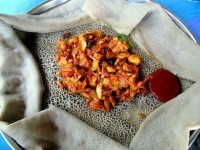

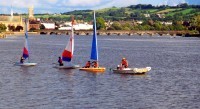
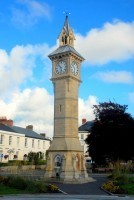
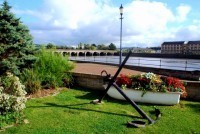
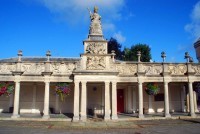
Blog post by Roderick Phillips, author of Weary Heart – a gut-wrenching tale of love and test tubes.
The post Africa to Europe, Days 364-365 appeared first on Roderick Phillips.
July 27, 2014
Rafting the Nile at Jinja, Day 363
Whitewater rafting scares the crap out of me…and yet I continue to do it. Why is this? I think it goes back to something I’ve touched on in past blogs, namely that traveling reduces inhibitions and makes me more likely to undertake crazy, if not downright dangerous, activities – perhaps in a vain attempt to prove (to who? Me?) that I’ve got what it takes. That I’m tough. Quite how many times I need to prove my manhood to myself I don’t know. I’ve already survived whitewater rafting in New Zealand, Australia, USA, Argentina, Zimbabwe, and now god-willing, I’ll survive the Nile. A few years ago I rafted the Zambezi River in Zimbabwe, which also proclaimed to have some of the world’s wildest whitewater, but now apparently, rafting the Nile at Jinja (just as the river exits Lake Victoria) is the new unmissable adrenaline junkie activity. I feel I can’t leave Uganda without adding this notch to my belt. The company I sign on with is called Adrift who proudly advertise: No one can hear you scream…under water, which is just so damn comforting.
While Adrift’s guides might be considered experts, there are 9 of us who have never rafted the Nile before. Is my life in their hands? Having done this a few times I know the basics, but the rest of my team are paying rapt attention to the instructions. I will be rafting with two Polish guys, 5 seriously gung-ho American Christian missionaries (all girls and all under 25), plus Kevin, a timid British Roman Catholic priest. The most daunting fact is the number of class V rapids (the highest commercially navigable). These are the toughest rapids and the ones most likely to cause problems, such as a long swim through churning whitewater that drags you repeatedly beneath the surface of the Nile. Is it too late to turn back?
The missionaries have raised thousands of dollars to visit 11 countries in 11 months spreading the word of god, although quite who they are expecting to convert aboard a raft heading through some of the most violent whitewater in the world is anybody’s guess. We begin with the class IV Bujagali Falls, which goes remarkably smoothly. Next up is Easy Rider, a mere class III rapid. As the name suggests, this is a classic roller coaster ride where the rafts race down a slick tongue of water then explode over a series of large crashing waves. Our guide asks whether we wanted Wild or Mild through Easy Rider. Well those damn evil missionaries will not listen to reason and they all yell “Wild!” Consequently, we plow straight into a flipper (a wave with the ability to overturn the raft). Still clutching my paddle, I am flung cursing and screaming from the raft (along with everyone else) into the noisy maelstrom of the Nile. My attempts to swim back to the boat are thwarted, however, by a bedraggled and shocked looking missionary who clings onto my paddle to stop herself being swept away. I thought Jesus sacrificed himself to save the rest of us. Well his missionaries have got a lot to learn. We are both tossed about in and under the wild water before being spat out of the rapid and eventually rescued by the safety kayaks. Still, the rapid was not a complete disaster for the missionaries as Kevin the Roman Catholic priest dislocated his shoulder and had to be evacuated off the river. Missionaries 1-0 Catholics.
The next big series of rapids are called Big Brother and the Silverback (actually four class V rapids back to back. You don’t want to get this one wrong). Clearly I have offended the Big Guy upstairs somehow and he has sent five angels of death to teach me a lesson. These crazy girls have no clue how to paddle or how to take direction and our guide is left to rue the fact that we hit Big Brother completely wrong. Not only is there no coming back from this for any of us, but our reward is a long swim through three towering class V rapids. I swallow so much water, I actually catch a couple of fish in my mouth.
The only positive to come out of this long swim is that the girly missionaries are now somewhat humbled. Their early morning arrogance is replaced by a slightly more somber approach. There are no more calls to flip and despite tackling additional class V whitewater we spend the remainder of the day in the raft. I’m very relieved to have survived my last adventure in Africa, my last adventure on our Year of Wonder, and my last ever whitewater rafting experience. I guess I like my adrenaline junkie activities just a little more sedate – like reading a book in a hammock with a cold drink (but don’t tell Christi I said that).
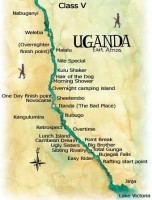
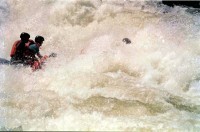
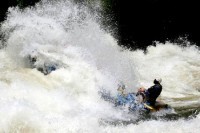
Blog post by Roderick Phillips, author of Weary Heart – a gut-wrenching tale of love and test tubes.
The post Rafting the Nile at Jinja, Day 363 appeared first on Roderick Phillips.
July 26, 2014
Fort Portal market, Day 362
Naturally, the day we leave Fort Portal is the day the town awakens from its slumber to host the weekly market. The market is located at the bus station and the bus from Fort Portal back to Kampala is delayed. At this early point in the morning many of the people at the market are selling snacks for the trip. Similar to a Thai satay of a Middle Eastern kebab, meat skewers seem particularly popular as do fried matoke (starchy green bananas commonly eaten in Uganda). A sign in the middle of the market points to nearby public toilets. The sign is given a wide berth by the locals, which makes me think the toilets themselves may not be that clean. Just a hunch; I don’t intend to find out. Once we finally leave Fort Portal, past the tea plantations we visited yesterday, we encounter many people on their way into town for the market. One guy on a bicycle is completely weighed down by matoke; I don’t know how he stays upright. We also see several Ankole-Watusi cows. These are remarkable creatures. They have been bred specifically to tolerate extreme changes in temperature and weather conditions. Their large horns act as temperature regulators, disseminating heat from the circulating blood supply and keeping the cow cool. The horns of the Ankole-Watusi cows are actually hollow, saving the poor beast from a permanent headache, but offering little in the way of defensive support.
The journey back to the Ugandan capital, Kampala, is probably the smoothest we have endured and for the only time during our bus adventures in East Africa we are not the only Mzungus (Kiswahili for foreigners) on board. Arua Park remains a hell hole. Seriously, if the Uganda government / army want to do something useful they could start by leveling Arua Park and starting again (not sure if I need to qualify this, but after they have moved the people out first). It takes an hour for our Link bus to get into the bus depot and another 30 minutes for our taxi to escape the mayhem. Christi and I spend yet another night at the Backpackers hostel. And the power fails again. If you took the Backpackers hostel and Arua Park out of the equation Uganda is actually a great place to visit (the homophobia aside).
Tomorrow is our last full day of potential exploration in Uganda and Africa and our Year of Wonder. I can’t believe our travels are almost over. I think I am going to cry. This puts me in the midst of a dilemma. Should I do something tomorrow or let the day fade away into anticlimax. Christi is adamant that she is doing nothing adventurous or energetic. She argues for a lazy day in a hammock with a good book and plenty of cold drinks. I on the other hand am toying with a rather reckless last day. It is often regarded as a highlight of Uganda if not Africa in general. It is an activity for adrenaline junkies and not for the fainthearted. I don’t really want to do it, to be honest, but if I don’t do it now, I know I never will. Decisions, decisions…
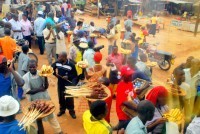
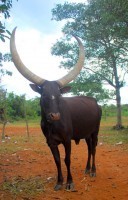
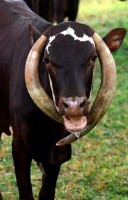
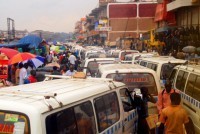
Blog post by Roderick Phillips, author of Weary Heart – a gut-wrenching tale of love and test tubes.
The post Fort Portal market, Day 362 appeared first on Roderick Phillips.
July 25, 2014
Kijura Tea Company, Day 361
I think it is time I come out of the closet and admit that I am a tea addict. There I’ve said it – and I feel much better… I suppose there are worse things to be addicted to than tea, but when you live in a country that does tea differently to that of my native country (USA and UK respectively) this can be very challenging. I hope you noticed that I said ‘different’ – not better or worse; just different. I have honestly attempted to immerse myself in the alternative tea-drinking culture of the USA, but failed miserably. Back in the day when I switched sides of the Pond to pursue my scientific career I admit to being quite naive regarding the way Americans consumed tea. I bought Lipton’s tea from the grocery store, because that seemed to be the only brand on the shelves at that time. Unfortunately the packaging had more taste than the contents of the bags. If I asked for a cup of tea in a cafe or restaurant, the first mistake, sorry difference, is that the water is never boiling hot. How do you make a pot of hot tea when the water is tepid or lukewarm? You are setting yourself up to fail. Then there is the choice of tea. I am a PG Tips kind of man, which means a simple black tea. I don’t do herbal tea or change the type I drink based on the seasons, or my mood, or the phases of the moon. It’s PG Tips every morning, every afternoon, every evening and several times in between. Lastly the milk. Half-and-half is not milk; I’m not entirely sure what half-and-half actually is or that it originates from planet earth. I think it was dumped here aeons ago by aliens who were glad to rid of the stuff. Personally, I use 2% milk – just enough fat to give the tea body, without overpowering the inherent flavor. I also drink a mug rather than a cup simply to enjoy more of my liquid addiction. My tea drinking experience is rounded off with a sweet snack, but I fully admit this is an optional extra. I had so many disappointing cups of tea in my first few years in America that I eventually became very reclusive in my tea drinking habits. Now it is something I do in private, behind closed doors, where no one is watching or judging me. Live and let live I say. In public I drink hot chocolate. By and large I like the way America makes hot chocolate. I do have to persuade the preparers to actually boil the water or milk, but in the end we live in relative harmony with one another.
Well I’m not quite where all that came from. Years and years of repression no doubt. It can be tough being British. The reason we are even talking about tea is that for the first time on our Year of Wonder, Christi and I are visiting a tea plantation. Tea, much like meat, is something I buy in the grocery store without much thought as to how it get’s there. In fact, I particularly don’t want to know the gory details of what goes on in a slaughterhouse, but a tea plantation sounds soothing and relaxing and I don’t think the leaves are screaming as they are being plucked. I also did not realize that many countries in East Africa, including Rwanda, Uganda, and Kenya produce some of the world’s best quality tea. Apparently it’s all to do with a favorable climate and soil conditions.
Uganda’s renaissance as a tea producer (after the dark days of Idi Amin) stems from investment from the Indian sub-continent and the Kijura Tea Company has been recently bought out by Jay Shree Tea. Christi and I tour a plantation and learn that not only are there tea pluckers (who snip off the top two leaves and a bud of the tea-plant), but pruners and weeders as well. In Uganda the best tea pluckers earn about US$100 per month and it is back-breaking work. At the factory the leaves and buds then goes through a series of steps including withering (predominantly to remove excess water from the leaves), fermenting (highly important in the formation of many taste and aroma compounds, which give a tea its liquor colour, strength, and briskness), fixing and drying (to stop fermentation), and sieving. Apparently the size of the leaf also affects the taste and whether it is appropriate for use in tea bags (a lucrative market). The highest grade tea at Kijura sells for US$2.50 per kilo. Naturally we get to taste different fractions of the leaves, which have different grades. Sadly my palette is poorly developed because I can’t tell the dregs from the top quality fractions. But at least I got a free cup of tea and I have been craving a decent cup of tea for 360 days.
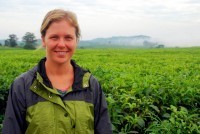
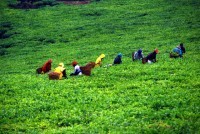
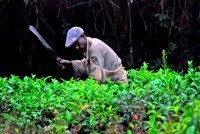
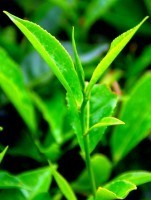


Blog post by Roderick Phillips, author of Weary Heart – a gut-wrenching tale of love and test tubes.
The post Kijura Tea Company, Day 361 appeared first on Roderick Phillips.
July 24, 2014
Semuliki National Park, Uganda, Day 360
Karabole Tours in Fort Portal organize two activities for Christi and I, the first of which is a visit to Semuliki National Park. Although only given national park status in 1993, Semuliki Forest Reserve was created in 1932. The area actually had a high prevalence of African Sleeping Sickness and Yellow Fever and to eradicate these diseases, the local indigenous peoples were evicted from their traditional forest homes. This included the Batwa pygmies and with a bit of luck we will also visit this tribal grouping as part of our excursion. The main entrance to Semuliki National park is only 27 km from Fort Portal, but most of that distance is vertical – up and over the famous Rwenzori mountain range. This range is the highest in Africa at over 5,000m (16,400 feet), although the highest peak is Mt. Kilimanjaro. The Rwenzori mountains have one of those very cool sobriquets: The Mountains of the Moon, which is up there with The Lost City of the Incas for sheer charisma and sales appeal. It is possible to trek through the mountain wilderness, but it is cold and wet. So the saying goes, the Rwenzori mountains are where Jesus came to learn how to walk on water! For the moment Christi and I content ourselves with a wide 3-hour detour, crossing The Mountains of the Moon at Buranga Pass.
The Buranga Pass offers views over the Semuliki River, which is the border between Uganda and the Democratic Republic of the Congo (formerly Zaire. Here’s a fast tangential fact for you, only Zaire, Haiti[both in 1974] and Brazil [2014] have conceded 5 goals in the first half of a match at the World Cup Finals!). For all the troubles in the DRC, the name Congo just sounds exotic and dangerous. If Christi and I had more time (apparently a year is just not long enough) may be we would ventured over the border. Having said that Semuliki National Park is the easternmost extent of the Great Ituri Forest of the Congo basin, so technically we are leaving East Africa and entering Central Africa. And the rainforest here is different; it is the loudest tract of jungle we have ever visited as a plethora of monkeys (including black and white and red colobus monkeys, blue monkeys, and the gray-cheeked mangabey) swing through the canopy far above our heads. Moreover, who knew there was geothermal activity in the middle of Africa, yet the Sempaya hot springs and geysers are bubbling away quite happily; hot enough in fact to boil eggs and bake potatoes for lunch.
Another irresistible draw for me is the presence of a tribe of Batwa pygmies that had also been forced out of their traditional forest homeland and into the surrounding non-pygmy communities. Traditionally these people were hunter-gatherers, dependent on Semuliki forest for food, shelter, medicine and tools, although this is beginning to change as a result of interaction with other local tribes. Interracial marriage has become increasingly common and one slightly humorous result of these marriages is that the pygmies are becoming taller! The chief of the local Batwa pygmy tribe and his mum are, however, 100% pure and they are tiny little folks. For a fee they are happy to be photographed and I’m happy to oblige. One wonders how long it will be before the Batwa pygmies disappear into the history books. It’s been a great day in Central Africa.
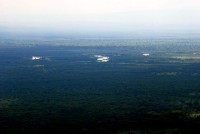
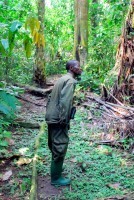
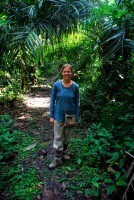
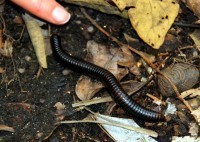

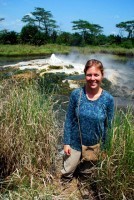
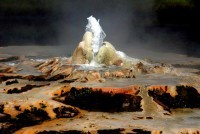

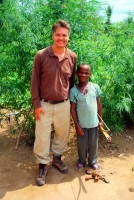
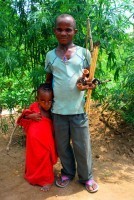
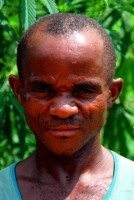
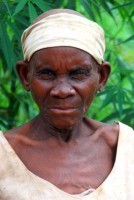
Blog post by Roderick Phillips, author of Weary Heart – a gut-wrenching tale of love and test tubes.
The post Semuliki National Park, Uganda, Day 360 appeared first on Roderick Phillips.
July 23, 2014
Murchison Falls National Park redux, Day 359
Christi and I are in the last week of our Year of Wonder, although even now our pace does not slacken. Our recent trip to Murchison Falls National Park was fantastic; our return to the Backpacker’s hostel in Kampala less so. The hostel is a rowdy, impersonal kind of place. It is cheap, though, which is why we keep coming back, but we don’t stay long. Indeed after just a single night we’re off again. This time we’re heading west, to the easternmost extension of the Congo Basin. Now the Congo Basin really does sound exotic and dangerous (for reasons other than civil war). Perhaps more dangerous than the Congo Basin, though, is Arua Bus Park in Kampala. Given the choice I’d take the Congo over Arua Park every day of the week. Arua Park truly is a god-forsaken place always jam-packed with vehicles belching out noxious fumes. Quite why a market sneaks along the road and sidewalk here further adding to the congestion is beyond me. Christi and I are both in agreement that Arua Park is hell on earth, while Kampala is a pimple on the asshole of humanity. One should not confuse Kampala with Uganda generally, though, because from what we have seen the country is recovering well from its recent traumas (Note we visited Uganda before laws were introduced to outlaw homosexuality. If found guilty, the penalty is life in prison). Unfortunately any bus that we need to take appears to leave from Arua Park. Today we are taking the Link bus service to Fort Portal, some 200 miles to the west of Kampala.
The first half of the 5-hour journey is blighted by road construction and speed bumps. Our bus driver completely ignores the speed bumps, however, and those of us at the back of the bus are continually thrown out of our seats. (Fast fact. Road construction here as it is in Kenya, Ethiopia, and Sudan is performed by Chinese contractors. Typically, though, the results are not that impressive. What is surprising is that the state of California awarded a multi-billion dollar contract to replace the Yerba Buena Island to Oakland span of the new Bay Bridge to Chinese contractors. The Chinese literally constructed concrete sections of the bridge in China and then shipped them across the Pacific Ocean – and it was still cheaper than anything contractors in the USA could do. Now the quality of the work on the Bay Bridge – well, time will tell…). Anyway, I digress. Actually I do mean to digress, only I thought you might enjoy some quiet reflection on our recent visit to Murchison Falls National Park. I’ve included a few more photos to create a suitably relaxed mood. And while you do that, Christi and I are collecting a fair few bumps and bruises en route to Fort Portal, gateway to the Heart of Darkness.
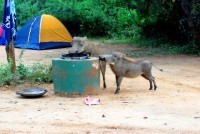
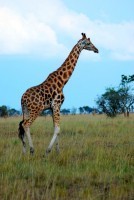

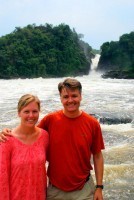
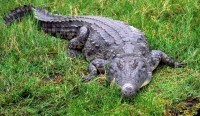
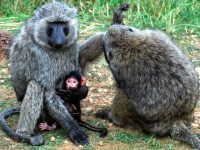
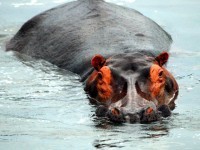

Fort Portal is actually a rather amiable, easy-going place, like a retirement community. I doubt if anything terribly exciting ever happens here in the normal course of events. We taxi from Fort Portal bus station to the Rwenzori Travellers Inn and while we’re checking in there is a tremendous screech of brakes as a truck plows into several vehicles parked on the street outside the hotel, about 10 yards from where we are standing. Perhaps Fort Portal will be more exciting than I had expected! By the way there were no serious injuries in the multi-vehicle pile up. The driver blamed the incident on brake failure. Come to think of it, I’m amazed Christi and I have not been involved in a serious accident in Africa because the roads and the driving here are both dire. Of course now that I’ve said that…
Blog post by Roderick Phillips, author of Weary Heart – a gut wrenching tale of love and test tubes.
The post Murchison Falls National Park redux, Day 359 appeared first on Roderick Phillips.
July 20, 2014
Murchison Falls National Park, Days 356-358
It’s an early morning departure for the 6-hour minivan ride to Murchison Falls National Park, 200 miles to the north of Kampala. Financially Christi and I are a bit below the level of a backpacker at the moment and we have literally scoured our backpacks and daypacks for any stray US dollar, euro, Ugandan shilling and Rwandan franc to help pay for this last safari. And this trip promises to be quite unique. Although poaching is a major problem in most African countries – either for food or for elephant ivory or rhinoceros horn – in countries such as Uganda, Rwanda, and any country with Congo in its name the problems are magnified ten times. Whole species are on the brink of extinction and extreme conservation efforts are under way in Uganda now that the country is somewhat at peace. The beneficiaries of these programs include chimpanzee and White Rhinos and we will visit both species during this trip. Added to this we return to the Nile; this time its’ the White Nile. Unlike the source of the Blue Nile (Lake Tana in Ethiopia) the actual source of the White Nile remains disputed. The best I can say is that Christi and I are close to the headwaters, but we do get to see the famous Murchison Falls themselves and if all that is not enough we will of course be going on safari. The only downside is that we are camping again. I know I have mentioned this before, but Christi and I are not natural campers and outside the continent of Africa my camping experiences have been negligible. Inside Africa, on the other, I have spent literally months under canvas (if you include all trips to the Dark Continent!).
We begin with chimpanzee tracking in the Kaniyo Pabidi Forest, located in the south of Murchison Falls National Park. There are 87 chimpanzees habituated to humans and according to our guide yesterday’s tour group saw 50. Clearly the chimpanzees are less enthusiastic today. Personally, I think they are all fagged out after an all night rain forest rave. It’s also raining. Frankly if I didn’t need to be out in the rain today then I’d be tucked up somewhere dry sleeping it off with a cute chimp from lat night’s party. To be fair we do see three chimpanzees, although from a photography perspective the environment is challenging. The canopy blocks out a lot of the light, while the chimps are swinging through the trees above us, arguably trying to avoid being captured on film. But you only need one photo, right? Which is about all I got. But at least I have something to show you guys. Phew!
We appear to be sharing our campsite with a resident population of warthogs who are much more sociable than the chimpanzees. In fact one could argue that the warthogs are extreme exhibitionists since they are happy to copulate in front of us – over and over again. If nothing else, I admire their stamina. And after all that sex, the warthogs are naturally hungry so they root around the rubbish bins looking for a tasty treat. So far Murchison Falls National Park is a blast.
The park is actually the largest in Uganda, measuring some 1500 square miles (the larger Murchison Falls Conservation Area encompasses 2000 square miles in which the wildlife can frolic in relative safety). The Victoria Nile River bisects the park for 71 miles and this includes the famous Murchison Falls. Here the waters of the majestic Nile squeeze through a narrow gorge, only 23 feet wide before plunging 141 feet below in an intense and powerful foamy spectacle. And it is loud too. This morning we take a two-hour boat safari up the Nile river from the Parra Ferry Crossing to the base of the falls. There is abundant wildlife en route: hippos, engorged Nile crocodiles (apparently there is a healthy population of Nile perch on which to feed), Cape buffalo, crested cranes, fish eagles, and antelope. Near the base of the falls we disembark and spend the next hour scrambling and photographing our way up the side of the falls and explore the surrounding area. In fact, there is very little separating the over-enthusiastic tourist (or photographer) from the edge of the violent, churning waters. So be warned and pay attention; you are only one slippery misstep away from a watery oblivion or worse a Nile croc snack.
Fortunately Christi and I survive to photograph another day. Or in the case an afternoon safari in the northern half of the park around the Buligi savannah grasslands. It’s another rich encounter and we even see a new antelope species, the Oribi, in addition to the familiar giraffe, elephants, antelope, and baboons. Sadly, though, no big cats – specifically no cheetahs or leopards. Boy are these guys hard to spot. An interesting experience back at the Parra Ferry Crossing. As we wait for the ferry to take us back to the southern section of the park, three men appear escorted by police. The police proceed to take out machetes and using the flat part of the blade lay into the three men. We send our guide to investigate (not wishing to be an accessory to murder or heaven forbid genocide). Apparently, the three men were caught in the act of killing a hippopotamus and will be sentenced to 7 years in prison each. The police are demonstrating the type of treatment the poachers will experience in prison. Well that’s alright then; no sense waiting for a trial and a conviction before initiating the punishment.
After another noisy night in the company of fornicating warthogs (I’m beginning to feel a bit inadequate), we leave Murchison Falls National Park en route to the Ziwa Rhino Sanctuary, some 40 miles to the south. Along the way we stop for snacks and a bio-break. I notice a newspaper for sale called the Sunday Pepper, which appears to be something like the National Enquirer. A prominent headline on the cover promises thigh-luscious content within. And there is, but Christi has banned me from sharing that content here as she argues that this is a family blog. Okay, let’s move on to Ziwa Rhino Sanctuary where these beasts could, arguably, be described as thigh-luscious. I mean what a phrase; I love it.
The Ziwa Rhino Sanctuary is attempting to reintroduce White Rhino back into Uganda’s national parks. Historically, White Rhino were found in Uganda, but the last animal was killed by poachers in 1983. Currently there are 6 adult White Rhinos (3 males and 3 females) and 9 calves. In 2009 The first White Rhino was born in Uganda for over 30 years. The adult female was donated by America and the father came from Kenya, so they called the male offspring Obama. The 17,000-acre park is guarded day and night by 80 armed guards, but fee-paying tourists like ourselves are allowed to explore and even undertake a walking safari (with an armed escort – although if it came to the crunch, I’m not sure if the guard would be protecting me from the rhino or the other way round). As with the Mountain Gorilla trekking, the guards know roughly where the rhinos are and it is fairly easy to find Nandi (the mother) and baby Obama. Fortunately, they are both quite relaxed around humans and as long as we keep quiet and don’t get to close the guard said he won’t shoot us. Well that is comforting! Another spectacular wildlife encounter. I am in seventh heaven. Now where are those thigh-luscious girls I’ve been reading about?
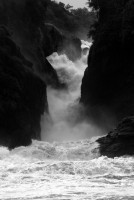
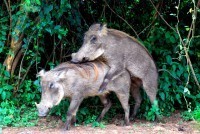
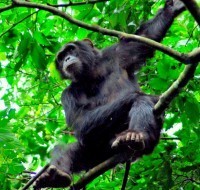
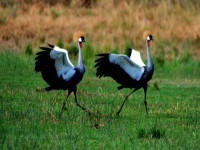
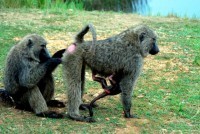

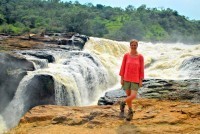
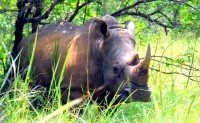
Blog post by Roderick Phillips, author of Weary Heart – a gut-wrenching tale of love and test tubes.
The post Murchison Falls National Park, Days 356-358 appeared first on Roderick Phillips.
July 19, 2014
Volcanoes National Park, Rwanda, Day 355
I was looking back at some of my earlier blog posts from the beginning of our Year of Wonder and noticed that I was much more restrained. My entries were shorter and to the point. Over the ensuing months I think I have become too enamored of my own voice. To that end I’ll try to make the sprint to the finish line as concise as possible. Having said that, it would be criminal not to spend at least little more time with the Mountain Gorillas of Volcanoes National Park. The genocide apart, Rwanda is probably most famous for its population of Mountain Gorillas and at about 480 individuals the numbers are, believe it or not, increasing and quite substantially – over 25% from 2003 to 2010 when the last census was performed. The scariest point in the modern conservation program was 1981 when only 254 individuals were believed to be in the tri-nation Virunga Mountains, of which Volcanoes National Park is a part. Of course the tricky thing about the gorillas is that they do not respect national borders. Currently, most are resident in Rwanda because of ongoing unrest in the Democratic Republic of the Congo. The rebound in gorilla numbers is very exciting, but at some point habitat destruction in Rwanda will harm this renaissance. Villagers who eke out a living on the precipitous slopes of the Virunga Mountains see very little benefit from the rich tourists who pass briefly through their hamlets, leading to some resentment which may in turn lead to fatal confrontation with the gorillas in their midst. So the Rwandan government has to find a balance to ensure that everyone benefits from the eco-tourism bonanza afforded by the Mountain Gorillas of Volcanoes National Park.
The situation is actually even better than I mentioned above because Uganda hosts a separate population of Mountain Gorillas in the Bwindi Impenetrable National Park, which lies to the north of Volcanoes National Park. The consensus data here is less clear, but it is believed that as many as 340 individuals inhabit this park. The entire population of Mountain gorillas is therefore in the range of 800-900 individuals and rising (none incidentally live in captivity or zoos)! But this success is due to intense conservation efforts on behalf of various governments and the Dian Fossey Gorilla Fund. There are two other subspecies of gorillas, the western lowland gorillas (who live in West Central Africa) and eastern lowland gorillas (who live in the eastern Congolese rainforest) that lack similar protective efforts.
Okay, here are a few fast facts about gorillas and then Christi and I really must board a plane:
Mountain gorillas reproduce slowly. Females only reach sexual maturity at aged 10 and over an entire lifetime (Mountain Gorillas live to about 35-40 years) they may have as few as 5 babies. Males do not reach sexual maturity until aged 15. Furthermore, only 50 percent of gorilla young survive their first year, although that number is likely to be higher in those groups habituated to man because they are protected and can receive veterinary care if necessary.
Mountain Gorillas and humans share 99.6% of their DNA. And while humans have unique fingerprints, gorillas have unique nose prints. Quite how anybody figured this out is unclear to me. I mean would you walk up to 400 lb silverback gorilla, rub ink on its nose and then try to get a print?
Mountain gorillas are the hairiest members of the gorilla family. They need long hair to keep warm at night in the Virunga Mountains. They live in families of 10 to 20, led by a dominant male called the silverback (for the silvery gray hair that grows as the male matures). Contrary to popular depictions, gorillas are not ferocious and aggressive, but rather gentle and shy (a bit like me really). The family unit typically spends 30% of their day feeding (Mountain Gorillas are vegetarian eating a variety of leaves, roots, flowers and bamboo when in season) , 30% moving and playing, and 40% resting.
Christi and I hate to leave these endearing gentle giants. It has been an amazing experience and we can only wish the Mountain Gorillas well. Their survival hangs by a thread. Man can either drive them to extinction or continue to nurse the species back to a viable population size.
In contrast to the tortuous, almost suicidal bus ride from Kampala to Kigali, our return journey is sublimely easy. The flight aboard RwandAir lasts 35 minutes, during which time I am served the fastest lunch of my life. But, hey, I had lunch. Entebbe International airport lies 39 km southwest of Kampala on the shores of Lake Victoria. It’s a US$25 taxi ride back to the Backpackers hostel and campsite, where we bump into a Dragoman group who are en route to Rwanda (Dragoman gets everywhere and I mean that in a good way). Christi and I barely have time to do laundry, eat, and repack ahead of tomorrow’s visit to Murchison Falls National Park.
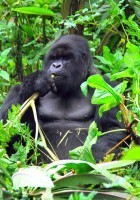
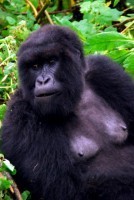
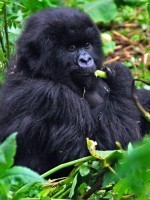
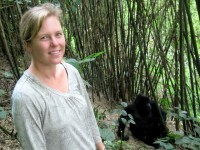
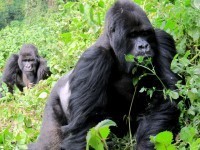
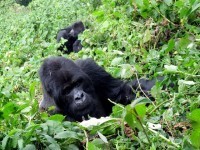
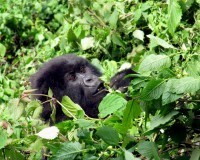
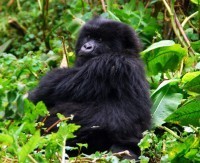
Blog post by Roderick Phillips, author of Weary Heart – a gut-wrenching tale of love and test tubes.
The post Volcanoes National Park, Rwanda, Day 355 appeared first on Roderick Phillips.
July 18, 2014
Mountain Gorillas, Volcanoes National Park, Day 354
Visiting the Mountain Gorillas in Volcanoes National Park is a haphazard business. Patrick, our driver-guide, brings us to the park HQ by 6.45 am. There are numerous tourists milling about and while Patrick signs us in at the visitor center, Christi and I learn a little more about the different gorilla families that we could visit. There are 17 groups of Mountain Gorillas that call Volcanoes National Park home. Seven of them have been habituated to humans and for the tidy sum of US$500 per person (currently US$750 and likely to keep rising) you are allowed to spend one hour with these gentle giants in their native habitat. A maximum of 8 people can visit each group – so a total number of tickets per day is 56. Not many at all, which is why during the peak seasons (June-September and December-February) tickets need to be purchased 6 months in advance. This is exactly what Christi and I did and then we had to make sure we got to Rwanda in time. And that was easier said than done as I related in an earlier blog. Anyway back to the gorillas. Somehow the 56 tourists with winning lottery tickets have to arrange themselves into seven groups of eight people and there are a number of factors that need to be taken into account when deciding which gorilla group you wish to visit. (Note, currently 10 groups have been habituated meaning there are now 80 tickets daily; visiting the Mountain Gorillas is a fluid business). First is the size of the group. The biggest is Susa, which is the original group studied by noted primatologist Dian Fossey. At one point there were as many as 42 individuals, including the dominant male silverback, Kurira, and the twins Byishimo & Impano (a rare event as a gorilla mother can normally only raise one baby at a time). Currently there are about 28 gorillas in this group. Other groups have smaller number (around 10 -15). Next is the location. Some groups, including the Susa group live high in the mountains and are difficult to reach. An exhausting trek in demanding terrain may not be everybody’s idea of fun. Christi and I want to visit separate groups, which then poses a logistical issue as we have to drive to the trailheads in our own vehicles and Patrick could only go to one location. Gallantly I let Patrick drive Christi and I bummed a ride with some of the other tourists.
Christi chose the Sabyinyo Group, which is much more easily accessed than the Susa Group (naturally I chose the most difficult group to access. Why do I do this? On the other hand, I think our recent ascent of Kilimanjaro has dulled Christi’s enthusiasm for strenuous hiking for the moment). The Sabyinyo Group is led by the powerful silverback Guhonda. Guhonda, the largest silverback of all the groups. I wave goodbye to Christi and we head off in different directions. I ride with some Irish folks in a mini-convoy to the trailhead. After 75 minutes of head-bumping, teeth-grating driving we reach our destination, which is surprisingly a village clinging to the slopes of the Virunga Mountains. It is these mountains, which cross the borders of Uganda and the Democratic Republic of the Congo, that forms the ever-diminishing habitat for the Mountain Gorillas. We hike almost vertically for 90 minutes. It is immediately clear why the gorilla habitat is shrinking as the villagers continue to cut down the rainforest in search of arable land to turn into agricultural terracing. Half of the mountain slopes have already been denuded of their rainforest canopy. Its like comparing a girl in a full-length skirt with one wearing a miniskirt.
Our guide insists we hike fast because the Susa group is on the move. We know this because armed guards are assigned to each gorilla group, partly for the gorilla’s protection and partly so that tourists can access the gorillas more quickly, and the guards and guides are in constant contact by walkie-talkie. Habituated to humans apparently is not the same as wanting to make life easy for humans. Indeed, the gorillas don’t stick to well-worn trails so we have to make our own trail through the lush, wet jungle. This is the complete opposite of hiking Kilimanjaro where we moved slowly through ultimately a lunar (or martian) landscape. The only common thread is the altitude. Now we’re hiking fast through steep, impenetrable jungle, and it is exhausting. By the time we finally spot the magnificent Mountain Gorillas I’m hyperventilating, dripping sweat, and would very much like a rest, but the clock is ticking. We only have 1 hour with these guys and there are rules, notably keeping your distance and no flash photography. The encounter is completely chaotic, though, because the gorillas don’t know the rules and they keep moving, circling further up the mountain, so humans and gorillas are almost bumping into one another. It is amazing to see how graceful the gorillas move in comparison to our own clumsy footsteps. Of course everyone is attempting to photograph these wonderful creatures and we all get in each other’s way (and the light is terrible for photography by the way so come prepared!). The antic of these guys are remarkably familiar: from the boisterous, curious toddlers, to the moody teenagers, the concerned mothers, and the alpha male; the toughest bad-ass gorilla in the group. You do not mess with this guy. If he tells you to back off, you ask how far. Fortunately, the Susa Group appears in relaxed and playful mood today and there are no problems. Kurira, the dominant silverback, does not feel the need to dominate and intimidate us. Rather he sits imperious gazing at his family and at the human interlopers.
‘Time to go,’ our guide informs us. What? Are you serious. It feels as if we’ve just arrived. We’re encouraged to descend while the gorillas continue eating and playing – oblivious to our departure. It’s an expensive business visiting the gorillas, but take my advice and buy two permits for successive days. One hour is just not enough. And maybe on that second visit you can drop the camera from your eye to simply enjoy being in the presence of these rare and gentle giants.
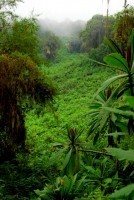


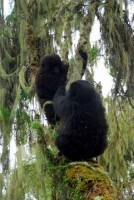
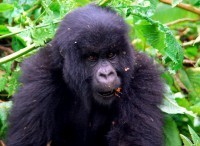
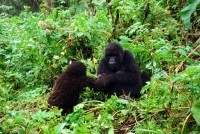
Blog post by Roderick Phillips, author of Weary Heart – a gut-wrenching tale of love and test tubes.
The post Mountain Gorillas, Volcanoes National Park, Day 354 appeared first on Roderick Phillips.

